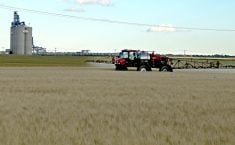total production yields
American beekeepers are unlikely to ever produce as much honey as they did in the 1990s, when yields regularly topped 200 million pounds a year, says an industry representative.
In fact, this year could be the worst honey crop ever in the United States, said Troy Fore, director of government relations for the American Beekeeping Federation.
Based on conversations he’s had with U.S. honey packers, Fore said American beekeepers will produce 140 to 145 million lb. of honey.
They have averaged 155 to 160 million lb. a year since 2006. Over the last six years, American packers imported approximately 250 million lb. of honey a year.
Read Also

New coal mine proposal met with old concerns
A smaller version of the previously rejected Grassy Mountain coal mine project in Crowsnest Pass is back on the table, and the Livingstone Landowners Group continues to voice concerns about the environmental risks.
Those figures were reversed in the 1990s, when production often topped 220 million lb. and imports rarely exceeded 150 million lb.
“I don’t know that it’s ever going to be like it was,” said Fore.
One factor behind the decline has been colony collapse disorder, a mysterious situation that has killed millions of honeybees over the last six years, but the loss of bee habitat in honey producing states is another factor.
Landowners have removed thousands of acres from the Conservation Reserve Program in the last couple years.
“They (farmers) are taking out CRP (land) and going to corn and beans, which aren’t honey producing plants,” said Will Nissen, a beekeeper from Minot, N.D. “It’s not just a few acres. We’ve lost a lot of habitat.… Hundreds of thousands of acres came out (of CRP).”
Beekeepers in other parts of the country have raised the same concern about CRP acres, Fore said.
However, corn prices higher than $7 a bushel and soybeans higher than $15 makes it challenging to convince farmers to leave land idle, even if it’s marginal land, he added.
“And I think it’s going to get worse, especially with commodity prices,” Nissen said.
As well, he said cattle numbers in North Dakota are declining, which means fewer alfalfa acres for bees.
Meanwhile, U.S. authorities have taken a more robust stand on illegal imports of Chinese honey.
In 2011, American journalists filed dozens of stories on Chinese exporters who sent their honey to another country, such as India, and then shipped the honey to the U.S. as a product of India.
Exporters routed the honey through India to escape U.S. tariffs of $1.20 per lb. on Chinese honey. The U.S. government instituted the tariffs in 2001 over concerns of Chinese beekeeping practices, including the storage of honey in lead drums.
The U.S. justice department recently charged several exporters for circumventing the tariffs, which cut the flow of honey into America.
However, Fore said that with honey selling for $2 per lb., it’s tempting for U.S. importers to skirt the law and buy cheap honey from China.
- 2000 220 84
- 2009 146 59
- 2011 148 60
- Canada produces 75 million pounds of honey annually — one-third comes from Alberta, another third from Manitoba and Saskatchewan and the remaining third from the rest of Canada.

















